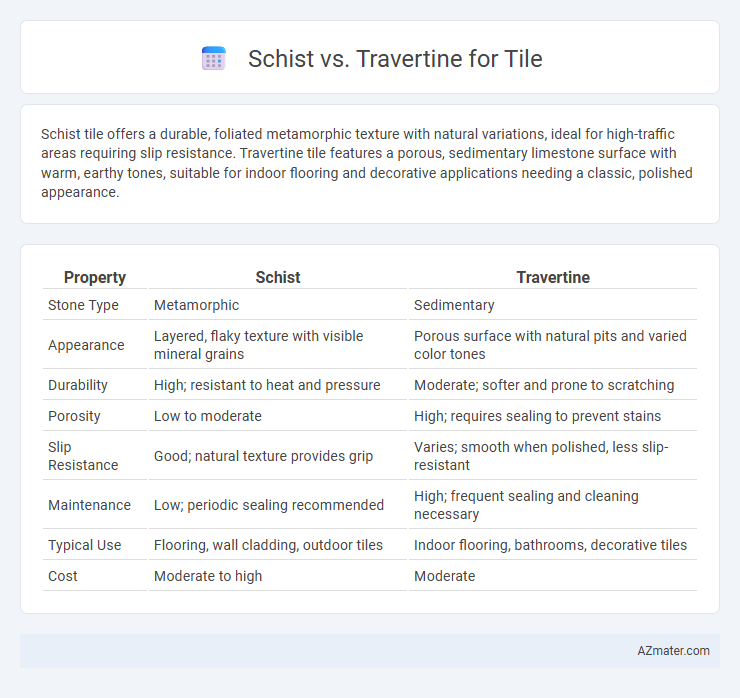Schist tile offers a durable, foliated metamorphic texture with natural variations, ideal for high-traffic areas requiring slip resistance. Travertine tile features a porous, sedimentary limestone surface with warm, earthy tones, suitable for indoor flooring and decorative applications needing a classic, polished appearance.
Table of Comparison
| Property | Schist | Travertine |
|---|---|---|
| Stone Type | Metamorphic | Sedimentary |
| Appearance | Layered, flaky texture with visible mineral grains | Porous surface with natural pits and varied color tones |
| Durability | High; resistant to heat and pressure | Moderate; softer and prone to scratching |
| Porosity | Low to moderate | High; requires sealing to prevent stains |
| Slip Resistance | Good; natural texture provides grip | Varies; smooth when polished, less slip-resistant |
| Maintenance | Low; periodic sealing recommended | High; frequent sealing and cleaning necessary |
| Typical Use | Flooring, wall cladding, outdoor tiles | Indoor flooring, bathrooms, decorative tiles |
| Cost | Moderate to high | Moderate |
Introduction to Schist and Travertine Tiles
Schist tiles, composed of metamorphic rock rich in mica and quartz, offer a textured, rustic appearance with natural layering and durability, making them ideal for areas requiring slip resistance. Travertine tiles, a form of limestone deposited by mineral springs, feature a smooth, porous surface with natural pits and veins, known for their warm tones and classic, elegant look in both indoor and outdoor applications. Both materials provide unique aesthetic qualities and functional benefits, with Schist emphasizing ruggedness and Travertine highlighting timeless beauty and versatility.
Geological Origins and Composition
Schist is a metamorphic rock formed under high pressure and temperature conditions that align its mica minerals into thin, shiny layers, primarily composed of quartz, feldspar, and mica, making it durable and textured for tile use. Travertine is a sedimentary rock that forms from the rapid precipitation of calcium carbonate in mineral-rich hot springs or limestone caves, featuring a porous, fibrous structure with natural pits and veins that give each tile a unique appearance. The distinct geological origins and mineral compositions result in schist tiles offering hardness and layered aesthetics, while travertine tiles provide a softer, more porous surface often used for decorative effects.
Visual Appearance and Aesthetic Appeal
Schist tiles exhibit a distinctive layered texture and natural shimmer due to their foliated mineral composition, creating a rustic and earthy aesthetic ideal for accent walls and flooring. Travertine tiles offer a smooth, porous surface with natural pits and troughs, showcasing warm, earthy tones and a classic, timeless elegance that complements both traditional and contemporary designs. The choice between schist's rugged, dynamic patterns and travertine's soft, marble-like veining ultimately depends on the desired visual impact and room ambiance.
Durability and Longevity
Schist offers exceptional durability with high resistance to abrasion and weathering, making it ideal for high-traffic areas in both indoor and outdoor environments. Travertine, while aesthetically pleasing with its unique porous texture, requires regular sealing to maintain longevity and prevent staining or erosion. Choosing schist over travertine for tile ensures a longer-lasting surface with less maintenance in demanding conditions.
Maintenance Requirements
Schist tiles require regular sealing and are prone to scratching due to their foliated texture, demanding consistent maintenance to preserve their natural appearance. Travertine tiles, composed of porous limestone, need frequent sealing to prevent staining and water absorption, especially in high-traffic or wet areas. Both materials benefit from gentle cleaning with pH-neutral cleaners to avoid surface damage and prolong tile longevity.
Suitability for Indoor and Outdoor Use
Schist offers excellent durability and natural slip resistance, making it highly suitable for both indoor flooring and outdoor patios, especially in areas exposed to moisture. Travertine's porous texture requires sealing for outdoor use but remains a popular choice for indoor spaces such as bathrooms and kitchens due to its elegant appearance and moderate durability. Both stones withstand various climates, but schist's robustness favors heavy foot traffic and harsher outdoor conditions more effectively than travertine.
Water and Stain Resistance
Schist tiles exhibit moderate water absorption and stain resistance due to their foliated texture, making them less ideal for wet or high-traffic areas without proper sealing. Travertine tiles, characterized by their porous nature with open holes and troughs, require thorough sealing to enhance water and stain resistance, especially in bathrooms and kitchens. Regular maintenance with appropriate sealants significantly improves the durability and appearance preservation of both Schist and Travertine tiles in moisture-prone environments.
Installation Process and Complexity
Schist tiles require professional installation due to their natural cleft surface and variability in thickness, demanding precise leveling and specialized adhesives to ensure durability and a smooth finish. Travertine tiles, while also natural stone, have a more uniform thickness but necessitate careful sealing to prevent staining and moisture infiltration during and after installation. Both materials benefit from skilled installers, but schist's uneven texture increases installation complexity compared to the relatively easier handling of travertine.
Cost Comparison and Value
Schist tiles generally cost more than travertine due to their unique mineral composition and natural layering, which adds to their labor-intensive extraction and processing. Travertine offers a more affordable option with a classic, porous texture that ages gracefully and increases property value when properly sealed and maintained. While schist provides a distinctive, high-end aesthetic ideal for luxury applications, travertine balances cost and long-term value, making it a popular choice for budget-conscious homeowners seeking durability and style.
Best Applications for Schist vs Travertine Tiles
Schist tiles excel in high-traffic areas and outdoor spaces due to their durability, natural slip resistance, and layered texture, making them ideal for patios, walkways, and rustic interior accents. Travertine tiles are best suited for indoor applications like bathrooms, kitchens, and living rooms where their smooth, porous surface and warm hues enhance aesthetic appeal and provide a classic, elegant look. While schist withstands harsh weather and heavy use, travertine requires sealing to prevent staining and is preferred for decorative, low-impact flooring and wall installations.

Infographic: Schist vs Travertine for Tile
 azmater.com
azmater.com